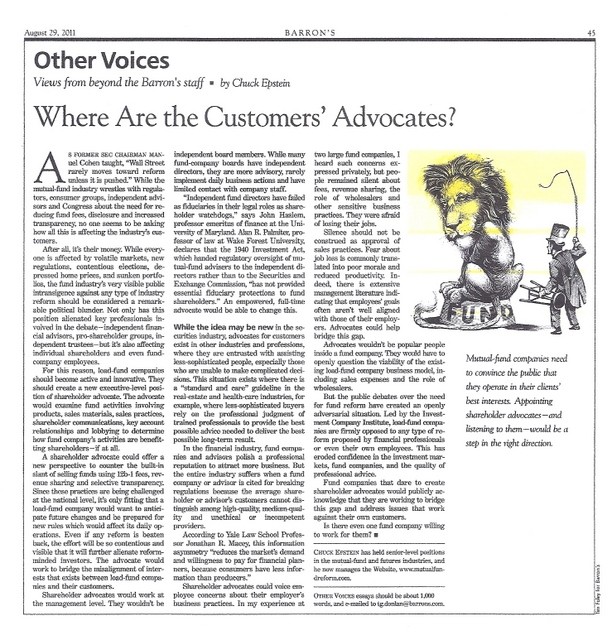Mutual Fund 12b1 Fees Key Reform Proposals
Post on: 16 Март, 2015 No Comment

Pr ep ar ed f o r M e m b ers an d Com m i t t ees of C ong r e ss
Rule 12b-1 was adopted by the Securities and Exchange Commission (SEC) in 1980 pursuant to
the Investment Company Act of 1940 (ICA). The rule allows funds whose boards approve 12b-1
plans (structures) under the rule to draw from fund shareholders aggregate assets to market or
advertise and distribute (sell) fund shares, something they had not been allowed to do.
Prior to 1981, funds were allowed only one means of compensating the broker who sold them, the
front-end load. But in 1980, the SEC adopted Rule 12b-1, after years of lobbying from various
funds who cited financial hardships and a need to use fund assets to underwrite expanded
marketing and distribution to boost their size, viability, ultimately lowering their investors costs.
The rule allows funds to deduct a percentage of a funds assets each year to pay the broker an
annual fee, the 12b-1 fee. Initially, the agency expected that 12b-1 fees would be a temporary fix
to help smaller struggling no-load funds to grow healthier. But fund companies began using the
fee to either eliminate or to offset front-end loads as well. Now, the vast majority of funds levy
12b-1 fees. The research consensus is that 12b-1 plans do not appear to have helped to lower fund
investors costs as was originally hoped. They have, however, helped to provide them with the
benefit of greater choice in the fund payment structures available to them. But some broker-
dealers who sell the funds may not be steering investors into the most beneficial structures.
Reports indicate that a minority of funds, that are closed to new investors, still charge 12b-1 fees.
Though the practice is permissible, critics condemn it as violation of Rule 12b-1s original intent,
allowing asset-based funding to attract new fund investors. Funds, fund distributors, and some
independent industry observers, however, say that investors in closed funds still demand and
receive attention from broker-dealers who may have sold a fund to them years ago and 12b-1 fees
still need to be collected to continue to pay for those services.
In a February 2004 proposal, the SEC asked for public comment on the need for additional
changes to Rule 12b-1. Among other things, it proposed requiring distribution-related costs to be
directly deducted from individual shareholder accounts rather than from aggregate fund assets,

potentially benefitting investors by giving them a more direct and thus a better understanding of
sales charges. But critics say such reform would result in investors accounts eventually paying
smaller nominal amounts as they age, giving broker-dealers added incentive to churn the
accounts. There are additional concerns that such changes might result in complicated record-
keeping burdens and added tax liabilities for investors. The 2004 proposal, also asked for public
comment on whether Rule 12b-1 should be repealed. But some observers have, however, noted
that the plans are ingrained in the financial system and repeal could mean reduced service for
small investors by brokers and a shift to front-end loads, which do have the benefit of greater
visibility relative to 12b-1 fees. In the spring of 2007, SEC Chairman Cox announced that due to
perceptions that 12b-1 fees had strayed beyond their original intent, the agency would be
reexamining 12b-1, which it is currently doing. If the agency adopts reforms, it might possibly
involve changes to the way 12b-1 fees are disclosed. H.R. 3225 (Castle) would direct the SEC to
improve the disclosure of fund fees and expenses.














